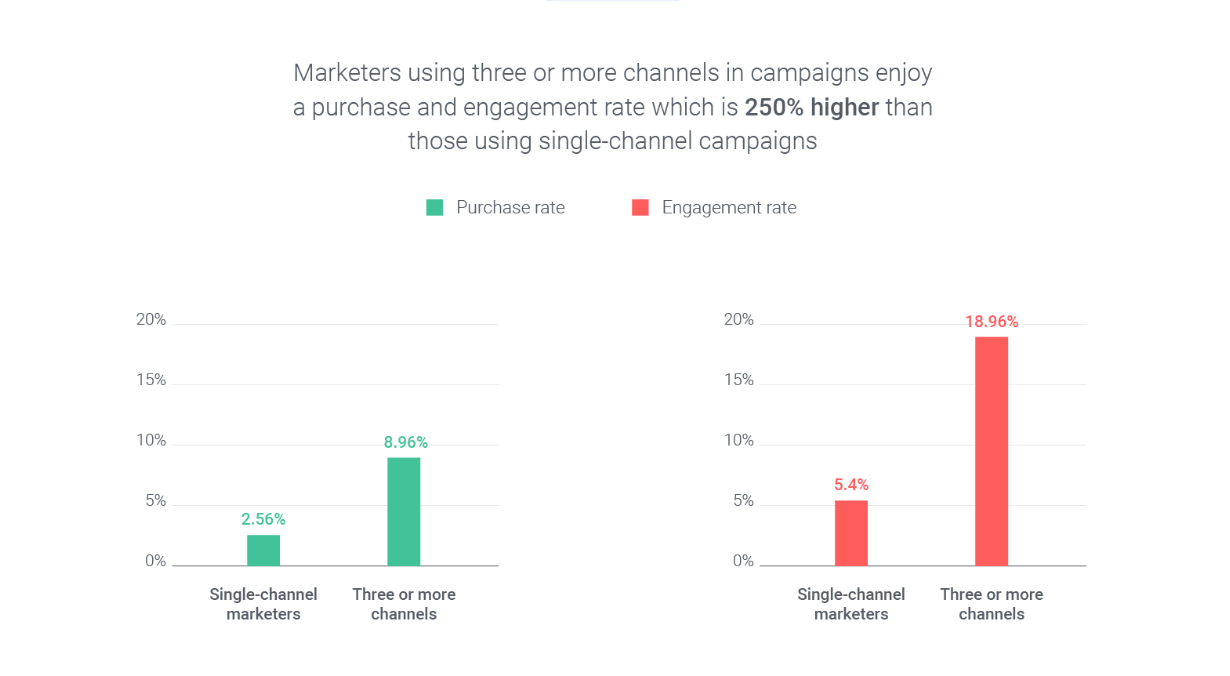Omnichannel marketing is a core element of how a customer experiences your brand. Especially in our day and age, where the pandemic changed the digital field as we know it.

The numbers are impressive.
Omnichannel marketing, however, is not something that can be achieved through conventional marketing methods. It requires an expert combination of digital marketing strategies, experiential marketing tactics, and offline experiences.
When these elements work harmoniously, brands can provide a seamless experience that will take the customer from point A to point B and, eventually, a purchase with little to no friction.
But how exactly is that possible? And what brands did it so successfully that you can copy their strategy? Let's find out!
Omnichannel Marketing: A Definition
A consumer's first contact with your eCommerce brand or product tends to be online. Whether it's due to your website, your social media presence, or your digital campaigns, the result is the following:
(Source: Agility CMS)
Consumers have adopted a digital-first approach when it comes to the eCommerce brands they want to experience. This is where omnichannel marketing comes into play.
Omnichannel marketing uses both online and offline tactics that nurture leads and lead them gently down the funnel, creating a memorable experience almost effortlessly. It allows consumers to interact with brands along their lead nurturing journey as they switch from offline to online tactics.
That way, the transition from an eCommerce marketing act shows a customer-centric brand.
From social media to chatbots and customer service agents to the brand new physical location of a previously online-only brand, omnichannel marketing for eCommerce can't work without a strong brand identity.
Omnichannel eCommerce Marketing: The Basics
There is no way to make your eCommerce omnichannel marketing strategy work without ensuring you've got some staples down before proceeding.
eCommerce marketing, in general, should be based on shopper insights, data and analytics, and, of course, ways to interact with your prospects at every step of the customer journey.
Your Online Presence
You should optimize your website for fast loading speeds and for marketing messages that are appropriate and can be used across your marketing channels.
Engage with your users through your social media marketing campaigns and share your link in a way that directs them to your website or landing page.
After that, use a sign-up for your email list incentive if they download your app.
Those channels should create a unified experience that is easy to navigate and promote your brand through your content in a non-salesy way. You don't need suspicious leads, as they could harm your ROI and deliverability rates down the line.
Adjust your marketing message according to your platform and use customer data to make sure you've got everything down to a tee. A consistent brand tone is everything in this case.
Your Customers' Data
Omnichannel marketing for eCommerce is heavily based on shopper insights and customer data. This is the only way you can lose guesstimates and create a strategy that makes sense to your customers, first and foremost.
For example, if your ideal audience and your existing customers frequent Instagram, make sure to interact with them there, then point them to your website. If this is not the case, utilize a different channel to boost your visibility and sales.
Pro Tip: A unanimous brand tone doesn't mean that your eCommerce brand has to use the same tone across all platforms. Your message should be adaptable and look and feel natural for your audience and the platform you choose.
Content, Design, and CTA
What are your trademark brand colors, and how do you use them to create a message that will get your point across? Is your marketing message synonymous with your brand's presence online? How do you use color psychology to engage, and how does your audience interact with your design?
The answers to the questions above will help you create and develop a content strategy that fits the platforms you want to use.
A sales pitch is as much of a content piece as a clever header image, but it would make no sense on a platform like LinkedIn or your homepage.
And the same goes for your CTAs. As a general rule, your CTA needs to be actionable and directly correlate to the rest of your content.
You wouldn't use an email CTA to redirect users to your Facebook posts, for example. And if your content is optimized for each platform, the same should apply to your CTA.
Also, never forget how easy it can be to repurpose content for your omnichannel eCommerce strategy. Since some types of content are top-funnel and some bottom-funnel, you will need to make adjustments here and a tweak there, of course. However, an agile content library is essential.
Being able to repurpose a blog post email design can help level up the omnichannel experience your brand offers.
The Brands That Nailed Omnichannel Marketing for eCommerce
Now it's time to see how brands used the tips above—and more!—and break down the ways they worked and how you could put them into action for your eCommerce brand.
Sephora
(Source: Sephora)
The first on our list is a beauty industry giant and one of the best at leveraging an omnichannel strategy. Sephora can integrate the brand's brick-and-mortar and online experiences in a fantastic way.
Using various devices and applications, Sephora creates an AR in-store experience that can be continued through its website and app.
Users can try on multiple products and automatically add everything they love to their wishlist using just one device.
Creating an in-store experience ROI and conversion rate in the comfort of their own homes. Not to mention how easy it is to purchase a product when users have fewer options.
Benefit Cosmetics
(Source: Benefit Cosmetics)
Another beauty giant specializing in face and brow products, the San Francisco-based brand created a fantastic omnichannel eCommerce experience with its "Brow Mobile" campaign.
Benefit Cosmetics launched an Instagrammable idea featuring a beauty van and a drive-thru experience, helping them connect with prospects and customers at all stages of the funnel. That way, they gained more exposure and boosted their CRO efforts.
Benefit Cosmetics didn't just stay in that lane, though. They also created a “virtual vanity” that allowed users to try on their ideal brow shape, thus simulating the function of their famous “Brow Bar”. And of course, let’s not forget their loyalty program, accessible only through their app.
Now, this is the tip you could steal. Don't hesitate to create a loyalty program that members can redeem through a more "guerrilla marketing" approach. That way, you'll gain more exposure and more followers, while your existing customers won't miss out on all the fun.
Amazon
(Source: Amazon)
Undeniably, Amazon is the most popular eCommerce brand and one of the best at creating omnichannel experiences.
Their focus is on creating fantastic experiences through personalized messages, spot-on suggestions, and interactions that make sense according to each channel.
This means that Amazon creates its marketing materials and omnichannel experiences by studying user data.
This creates an experience beyond purchase and into the heart of a customer's expectations, as their omnichannel strategy interacts with the user on a one-on-one level.
The main takeaway is using data to create marketing materials and shape a user's experience, from testimonial videos to expert product suggestions through your app. An omnichannel experience cannot be devoid of user data and must align with what the consumer finds natural and intuitive.
The Takeaway
An omnichannel marketing strategy for eCommerce is one of the core personalized experiences a brand can offer, as it can be unique and tailor-made to each individual.
Of course, those experiences are something every brand and eCommerce store can offer, especially with the wide variety of marketing platforms and tools that are readily available. The only thing to be mindful of is the way you create content and how your brand interacts with your audience.
Make sure you know exactly what your users need and how you can use your data. That way, you'll know the best way to reach your eCommerce KPIs while your users will have a brand that creates fantastic content and seamless experiences to look forward to.

Author Bio
Téa Liarokapi is a Senior Content Writer for Moosend, an email marketing and marketing automation platform, and an obsessive writer in general. In her free time, she tries to find new ways to stuff more books in her bookcase and content ideas—and cats—to play with.

